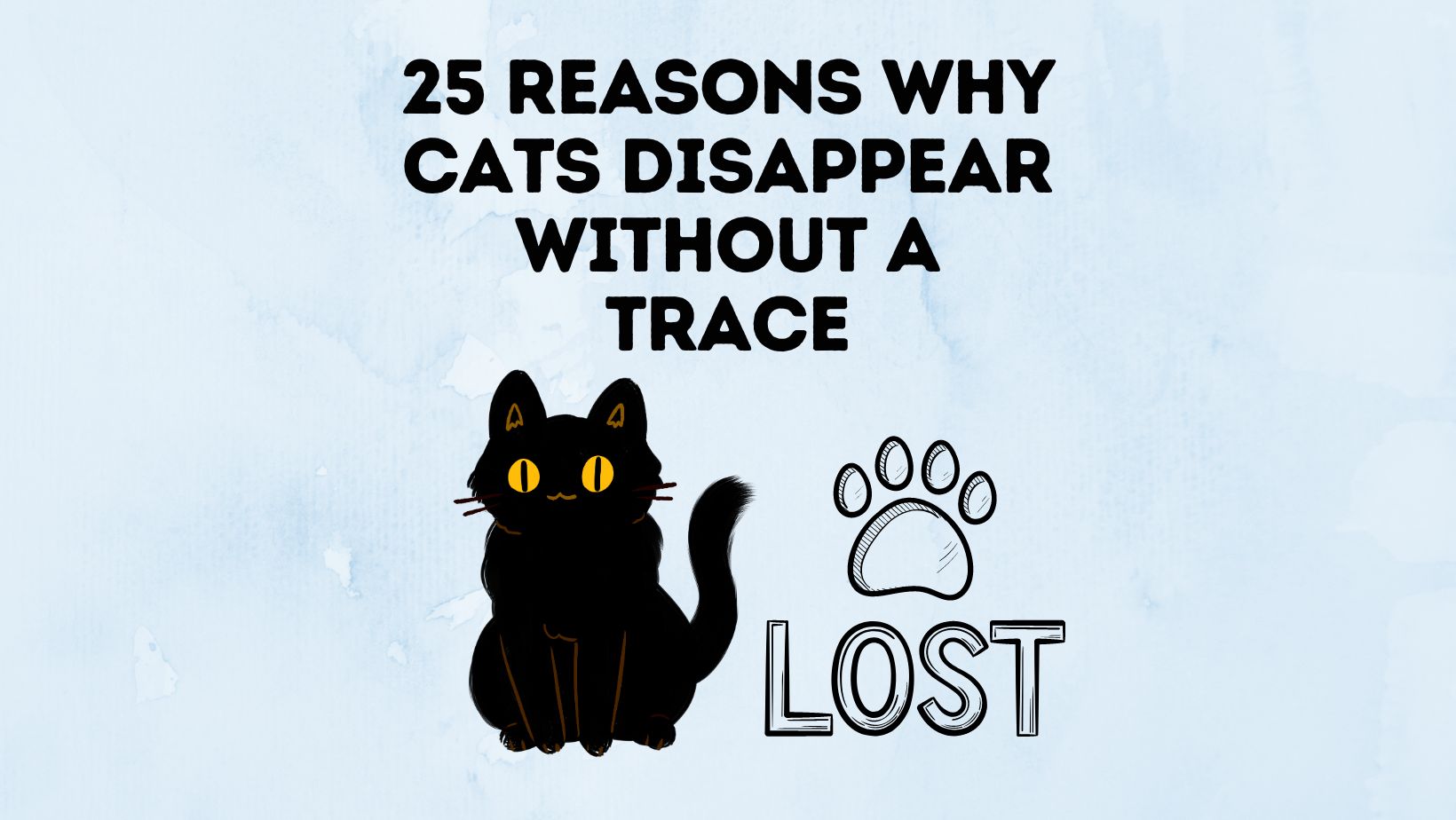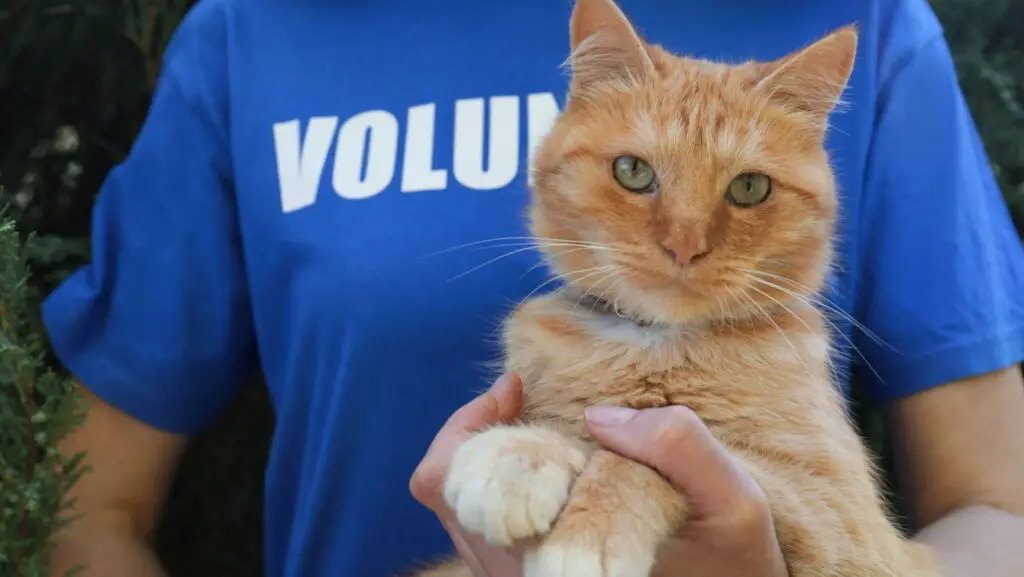
Cats are curious creatures and have a natural inclination to explore their surroundings. Unfortunately, this instinct can sometimes lead them to disappear without a trace, leaving their owners worried and anxious. There are several reasons why cats may go missing, some of which are natural and others that may require immediate attention. In this response, we will explore some of the reasons why cats disappear without a trace, along with detailed explanations and references from veterinarians and experts in the field.

Reasons For cats disappearance without a Clue:
Predators:
One of the primary reasons why cats disappear without a trace is because they fall prey to predators such as Predators, such as coyotes, foxes, and birds of prey, may attack and kill outdoor cats.
According to Dr. Julie Churchill, a board-certified veterinary behaviorist, outdoor cats are at a higher risk of being attacked by predators. She recommends keeping cats indoors to prevent such incidents. In addition, owners should also consider securing their yards and supervising their cats when they are outdoors.
Accidents: (Run over by Vehicles)
Cats are naturally curious and may get into accidents while exploring their surroundings. They may get stuck in tight spaces or fall from high places. They might get crushed by running verticals or trucks. Moreover, During summers cats try to hide under vehicles for shade and avoid sun rays and unknowingly drivers kill them being under tires.
Illness and Critical Diseases:
Cats may disappear without a trace if they are ill or have an underlying medical condition. According to Dr. Jules Benson, a chief veterinary officer, cats may hide when they are sick or in pain as a survival instinct. Owners should observe their cats for any signs of illness, such as changes in behavior, appetite, or litter box habits, and seek veterinary attention promptly.
Disorientation:
Cats may become disoriented and lost when they are in unfamiliar surroundings. This can happen when they are taken to a new location or when they wander too far from home. According to Dr. Churchill, cats have a keen sense of smell and can use this to find their way back home. Owners should leave familiar items such as bedding or litter boxes outside to help their cats find their way back home.
Stress or Anxiety:
Cats can also disappear without a trace if they are experiencing stress or anxiety. According to Dr. Katherine Houpt, a professor of behavior medicine at Cornell University, cats can become stressed by changes in their environment, such as the addition of a new pet or family member, or even changes in their owner’s behavior. Owners should try to minimize stressors and provide their cats with a safe and comfortable environment.
Behavioral Issues:
Some cats may have behavioral issues that cause them to wander or run away. According to Dr. Emily Levine, a veterinary behaviorist, cats may have separation anxiety or a desire to roam, which can lead them to disappear without warning. Owners should work with their veterinarians or a behavior specialist to address these issues and prevent future incidents.
Human Interference/Stealing:
Unfortunately, cats can also disappear due to human interference. They may be stolen or taken in by well-meaning individuals who assume they are stray or abandoned. According to the American Society for the Prevention of Cruelty to Animals (ASPCA), microchipping and collars with identification tags can help reunite lost cats with their owners.
Ingesting toxic substances or plants:
Cats may eat toxic substances or plants that can cause them to become sick or even be fatal. According to the ASPCA, common household items such as cleaning products, human medications, and certain foods can be toxic to cats.
Territorial disputes: (Conflicts with other cats)
Cats may have territorial disputes with other cats or animals, causing them to flee or become disoriented. According to Dr. Little, cats may become aggressive or defensive when they feel their territory is being threatened.
Chased by dogs or other animals:
Cats may be chased by dogs or other animals and become lost or disoriented in the process. According to the Humane Society, it is important to supervise cats when they are outside to prevent such incidents.
Trapped or locked in a building or vehicle:
Cats may become trapped or locked in a building or vehicle and be unable to escape. According to the ASPCA, it is important to check buildings and vehicles before closing them to prevent such incidents.
Injured or become ill while outside:
A cat may be injured or become ill while outside and may seek shelter in an inaccessible location. According to Dr. Little, cats may hide when they are not feeling well to protect themselves from potential predators or threats.
Extreme weather conditions:
Extreme weather conditions, such as storms or extreme heat, can cause cats to seek shelter or become disoriented. According to Dr. Becker, it is important to provide cats with shelter and access to water during extreme weather conditions.
Following/chasing prey:
Cats may follow prey or chase after it, leading them to become lost or disoriented. Cats may follow prey or chase after birds and become lost.
Accidental Transportation:
A cat may accidentally be transported away from home in a vehicle or while hiding in a delivery package.
Human error:
Unfortunately, some cats may disappear due to human error, such as being left behind during a move or accidentally being let out of the house. According to the ASPCA, it is important to take precautions to prevent such incidents and to have a plan in place in case a cat becomes lost.
Change in routine:
A change in routine, such as moving to a new home or a change in feeding schedule, can cause cats to become disoriented or stressed. According to the ASPCA, it is important to gradually introduce changes to a cat’s routine to reduce stress.
Lack of identification:
Cats without identification, such as microchips or collars with identification tags, may be difficult to reunite with their owners if they become lost. According to the American Veterinary Medical Association, microchipping is a safe and effective way to identify lost cats.
Escaping from carrier or leash:
Cats may escape from their carrier or leash while traveling or during a visit to the vet. According to Dr. Becker, it is important to use carriers and leashes that are secure and appropriate for the cat’s size and temperament.
Curiosity:
Cats are curious by nature and may wander off to explore new areas or objects. According to the ASPCA, it is important to supervise cats when they are outside to prevent them from wandering too far.
Lack of socialization:
Cats that are not socialized properly may become fearful or aggressive, causing them to run away or hide. According to Dr. Levine, it is important to socialize cats from a young age to prevent fear and aggression.
Mistaken for a stray:
Cats that are well-cared for may be mistaken for strays and taken in by well-meaning individuals or animal control. According to the ASPCA, microchipping and collars with identification tags can help prevent such incidents.
Medical procedures:
Cats may escape during or after medical procedures, such as surgery or dental cleanings. According to Dr. Becker, it is important to ensure that the cat is properly supervised and monitored during and after medical procedures.
Displaced by construction or renovations:
Construction or renovations to a home or neighborhood may displace cats and cause them to become lost or confused. and to avoid them they may run away to quiet places, According to Dr. Little, it is important to provide cats with a safe and secure environment during construction or renovations.

Where Do Lost Cats Go? Cat Vanished Into Thin Air
When cats go missing, they can end up in a variety of places. The location where a lost cat might end up can depend on various factors such as their personality, breed, the environment, and whether they are indoor or outdoor cats. Here are some possible locations where lost cats may go:
- Nearby hiding spots: Cats are known for being curious and agile creatures that can easily hide in nearby bushes, trees, and under cars. They might not go too far from their home territory if they are scared or disoriented.
- Local animal shelters: Many lost cats end up in animal shelters or humane societies. It’s important to check with local shelters as soon as possible and provide them with a description of your cat. Some shelters may also have online databases where you can search for lost and found pets.
- Neighborhoods and surrounding areas: If your cat is an outdoor cat, they may roam around the neighborhood or nearby areas. Asking your neighbors and posting flyers with your cat’s description and your contact information can increase the chances of finding your cat.
- Urban and rural areas: Depending on where you live, your cat might wander into urban or rural areas such as abandoned buildings, warehouses, parks, and forests.
- Taken outside the city: In some cases, lost cats may end up being taken out of the city by accident. They might hitch a ride on a car, truck, or other vehicle and end up far from home.
- Predators: Unfortunately, outdoor cats may be preyed upon by wild animals such as coyotes, hawks, or owls. It’s important to be aware of the potential dangers of outdoor cats and take measures to protect them.
It’s essential to search for your lost cat in all possible locations and to remain hopeful that you will find them. Keep in mind that cats are resilient animals and can survive for extended periods on their own.

List of Places To Look For Lost Cat
Here is a list of places where you can look for a lost cat:
- Immediate area: Start your search at home by checking your yard, garden, and any nearby hiding places. Cats that are lost or disoriented may be hiding in a nearby bush or under a car.
- Neighbors: Talk to your neighbors and ask if they have seen your cat. Leave them a description of your cat and your contact information in case they see your cat in the future.
- Flyers: Post flyers with your cat’s description, photo, and your contact information in your neighborhood and surrounding areas. Make sure the flyers are in visible locations and have large text for easy reading.
- Animal shelters: Contact local animal shelters and humane societies to see if your cat has been brought in. Provide them with a description of your cat and your contact information.
- Social media: Utilize social media platforms, such as Facebook and Nextdoor, to post about your missing cat. Many people share posts about missing pets and can help spread the word.
- Online lost and found pet databases: Many online databases allow pet owners to post information about their missing pets. Check these websites and post information about your missing cat.
- Food and litter outside: Leave food and litter outside your home to encourage your cat to return.
- Humane traps: If your cat is not responding to food and calls, consider using a humane trap to capture your cat.
- Veterinarian offices: Contact local veterinarian offices and leave a description of your cat and your contact information in case someone brings in a lost cat.
Remember to remain calm and patient during your search for your missing cat. Keep searching and asking around, as cats have been known to return home after several days or weeks.
FAQ’S Related to missing Cats
Is it normal for my cat to go missing?
Cats can go missing for a variety of reasons, such as wandering too far from home, getting lost or disoriented, or being taken in by someone else. While it’s not uncommon for outdoor cats to disappear for short periods, it’s essential to take steps to locate a missing cat as soon as possible.
How long can cats disappear?
The amount of time a cat can disappear depends on various factors such as the cat’s personality, breed, environment, and whether they are indoor or outdoor cats. Some cats may return home after a few hours or days, while others may take weeks or even months to return. It’s important to remain patient and continue searching for a lost cat, as cats have been known to return home after extended periods on their own.
Why do cats go missing when they die?
Cats may go missing when they are dying as they may try to find a quiet and secluded spot to pass away. In some cases, cats may leave their home territory and wander off in search of a peaceful place to die. It’s essential to be aware of your cat’s behavior and take them to a veterinarian if you notice any signs of illness or discomfort.
Why do cats disappear then come back?
Cats may disappear and then come back for various reasons such as hunting, exploring, or mating. Some cats may also be taken in by someone else and returned later. It’s important to have identification tags or microchips on your cat to increase the chances of being reunited if they go missing.
What are the chances of a lost cat coming home?
The chances of a lost cat coming home depend on various factors such as the cat’s personality, breed, and environment, as well as the efforts taken to locate the cat. According to a study by the ASPCA, approximately 74% of lost cats were eventually found and returned home. It’s important to take immediate action and search for a lost cat in all possible locations to increase the chances of being reunited.
Summary:
It is important to note that prevention is key when it comes to keeping our cats safe. Keeping them indoors, providing them with a safe and stimulating environment, and supervising them when they are outside can greatly reduce the risk of them disappearing without a trace. Additionally, microchipping and collars with identification tags can help increase the chances of reuniting lost cats with their owners.
If a cat does go missing, it is important to act quickly. Searching the immediate surroundings, posting flyers in the area, and contacting local animal shelters and veterinarians can help increase the chances of finding the missing cat. Social media can also be a useful tool for spreading the word and reaching a larger audience.
In conclusion, cats may disappear without a trace due to various reasons such as being attacked by predators, getting into accidents, being ill, or becoming disoriented. Owners should take necessary precautions to ensure the safety of their cats, such as keeping them indoors, securing their surroundings, and observing them for signs of illness. If a cat does go missing, owners should search their surroundings, post flyers, and contact local shelters and veterinarians to increase the chances of their safe return.

